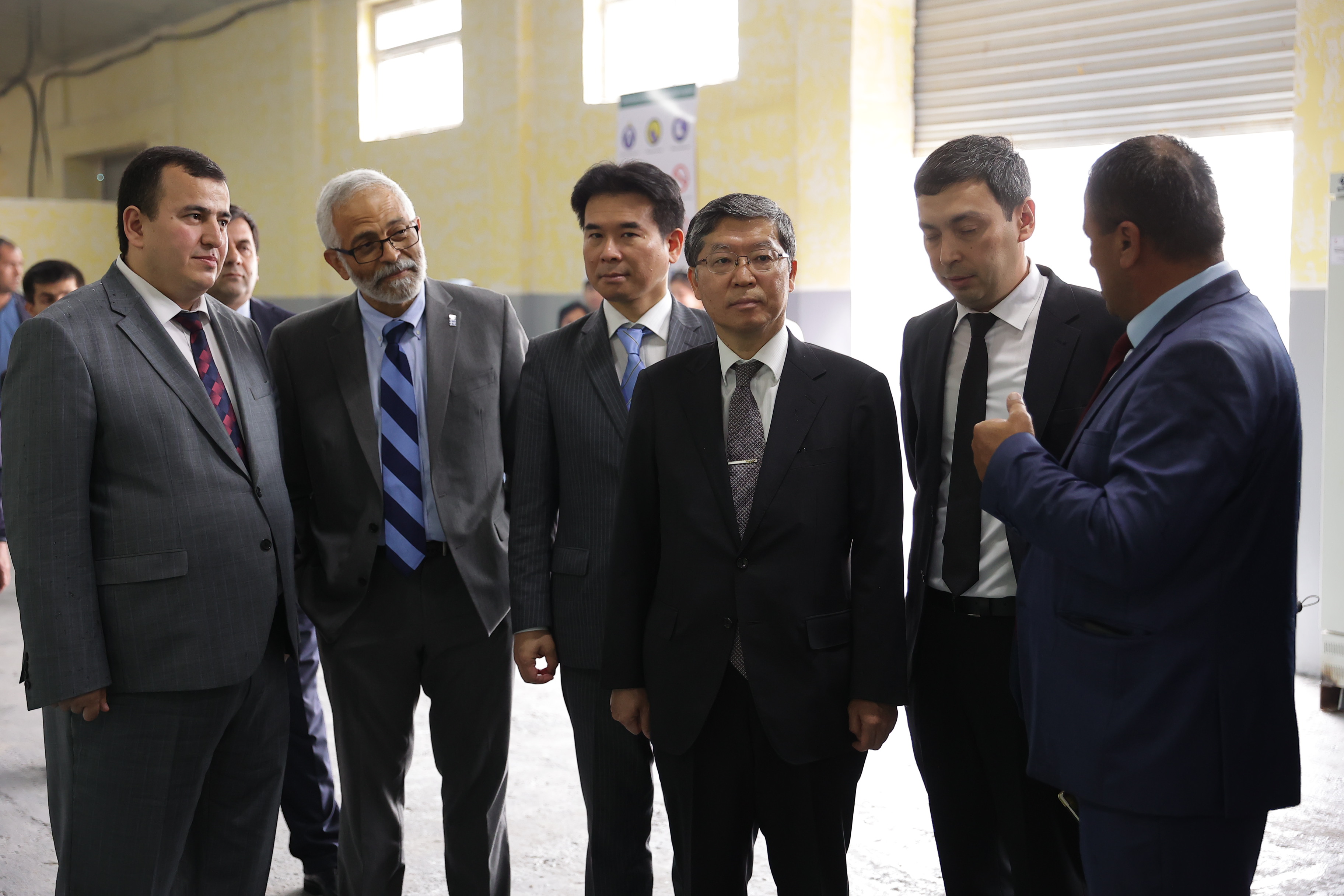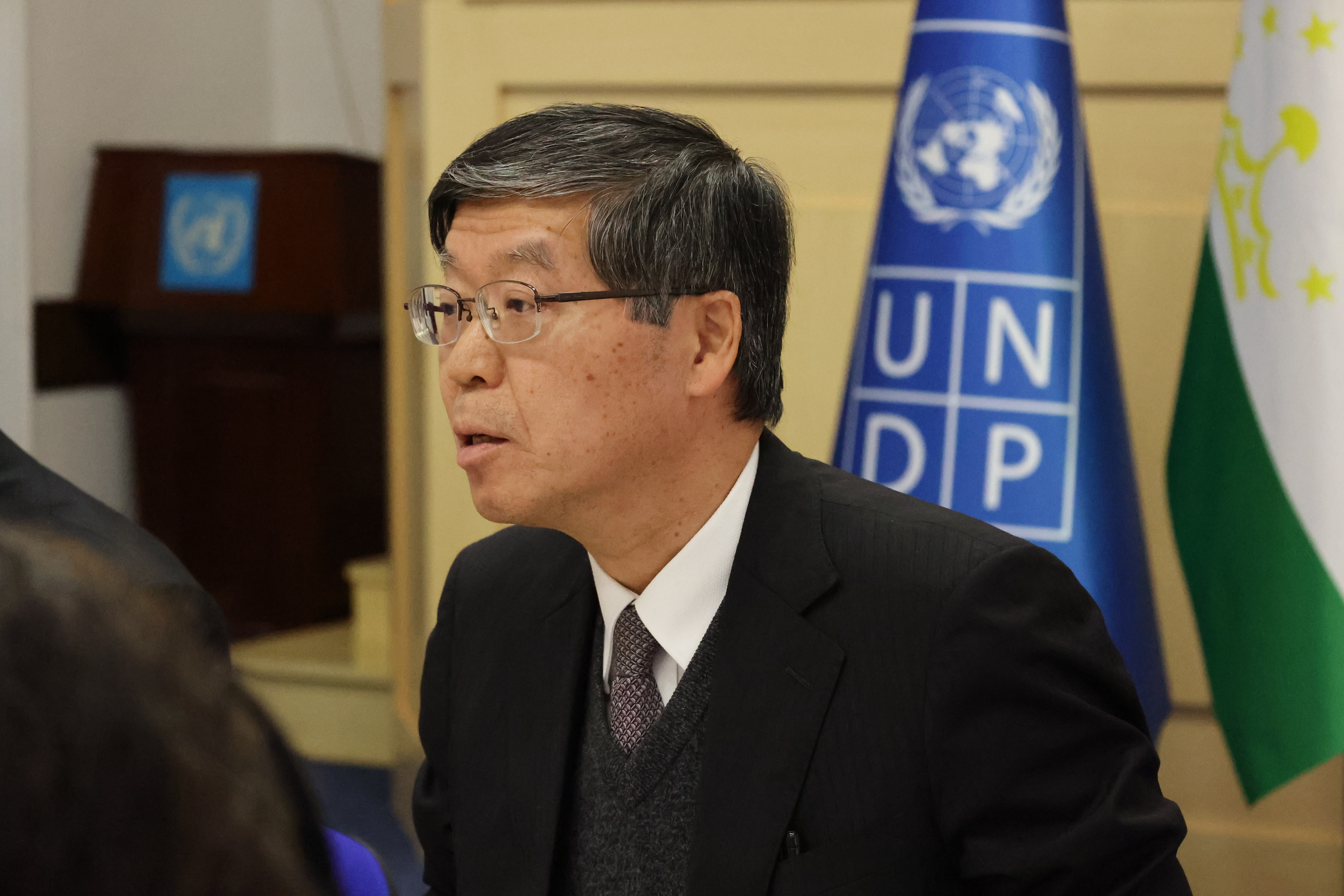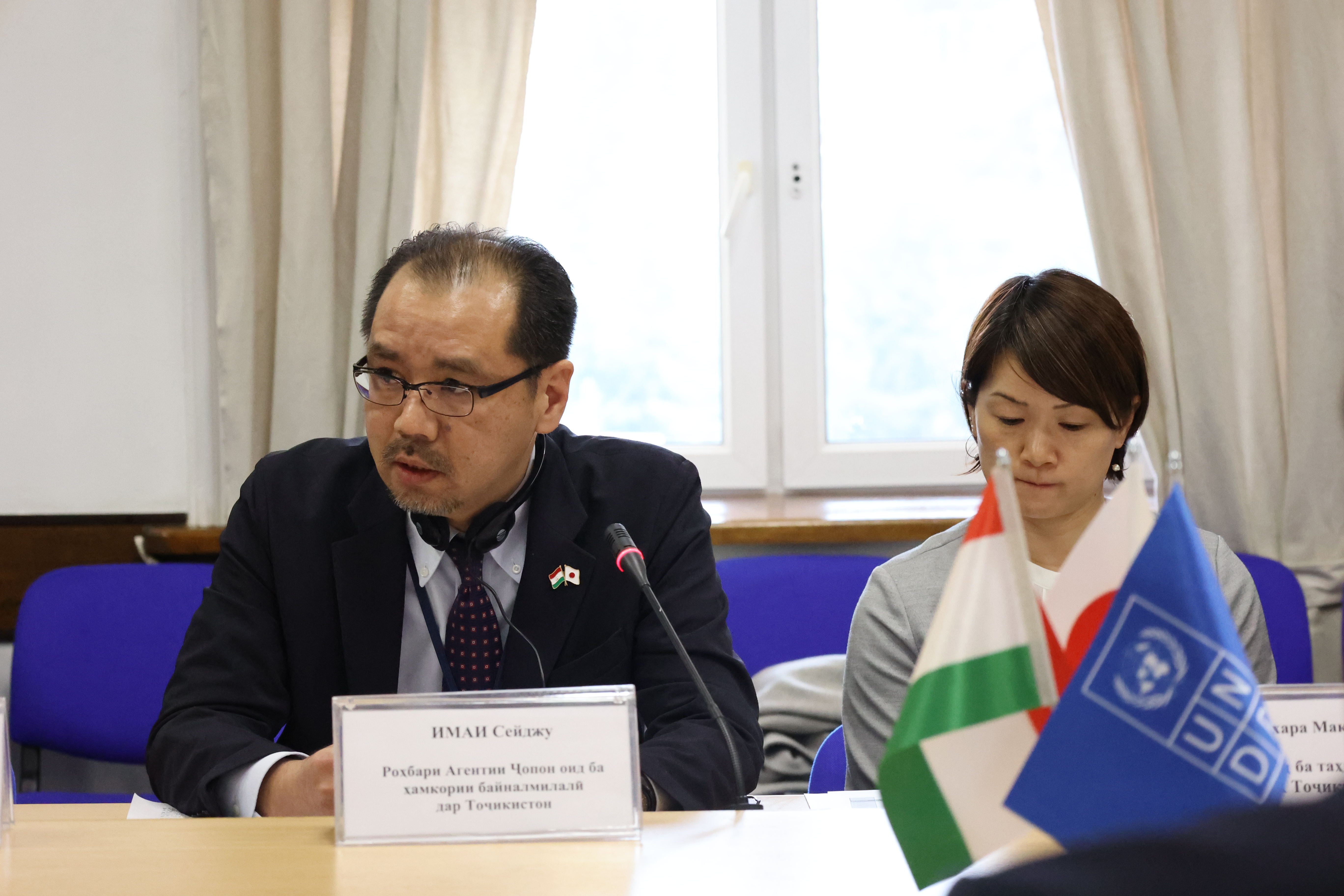UNDP and Japan's Enduring Collaboration Paves the Way for Tajikistan's Sustainable Development
February 8, 2024

From left to right: Abdurahmon Abdurahmonzoda, Deputy Mayor of Dushanbe, Lenni Montiel, UNDP Resident Representative in Tajikistan, Takasaka Muneo, former Chief Representative of JICA, Toshihiro Aiki, Ambassador of Japan, and others
In an unwavering commitment to sustainable development, Japan has been a steadfast supporter of Tajikistan, contributing dozens of millions of dollars to the republic’s development through UNDP. This significant partnership aligns with UNDP's mission of supporting the Government of Tajikistan in ending poverty, reducing inequality, and leaving no one behind, as outlined in the ambitious 2030 Agenda for Sustainable Development.
The Partnership between Japan, UNDP, and the Government of Tajikistan covers various sectors, primarily focusing on projects such as livelihood support and border management, disaster risk reduction, and climate resilience.
A prime example of joint efforts is the “Border Management Project” funded by the Government of Japan through JICA. This initiative, consisting of three phases, was initially launched in 2015, with the third phase commencing in 2023 and extending until 2025.
During a recent meeting on January 9, 2024, at the premises of UNDP that brought together representatives from the Embassy of Japan, Japan International Cooperation Agency (JICA), the Ministry of Foreign Affairs, and other relevant state committees and agencies, the parties reaffirmed their dedication to the ongoing collaboration.

Toshihiro Aiki, Ambassador of Japan to Tajikistan during a meeting at the UNDP office in Dushanbe, Tajikistan with representatives from the Ministry of Foreign Affairs and other ministries
Toshihiro Aiki, Ambassador of Japan to Tajikistan, reflecting on the importance of the BMP project maintaining open and secure borders, noted:
“We have had favorable relationships with the Government of Tajikistan since its first steps of independence. Japan supports Tajikistan in many ways, considering strategic aspects, especially in light of the changed political landscape involving the whole Eurasian continent. There are some challenges that not only Tajikistan but most of the countries face.”
Regarding collaboration with the Government of Tajikistan, the Ambassador highlighted the crucial role of the UNDP in successfully implementing intergovernmental initiatives.
“In this regard, the UNDP with its effective capabilities is a valuable partner. Over the years we have maintained a fruitful cooperation, leveraging UNDP’s global experience to successfully implement multiple projects in Tajikistan such as our joint BMP project,” added the Ambassador of Japan to Tajikistan Toshihiro Aiki.
In a collaborative effort between the Government of Japan and UNDP, the BMP initiative is dedicated to supporting the Government of Tajikistan in the effective management of its border. This partnership not only aims to enhance open and secure borders along the Tajik-Afghan border but also focuses on cross-border trade.

From left to right: Lenni Montiel, UNDP Resident Representative, Asliddin Gafurzoda, Head of the Department for resolving territorial and border issues of the Ministry of Foreign Affairs, Toshihiro Aiki, Ambassador of Japan during a meeting at the UNDP office in Dushanbe, Tajikistan with representatives from other ministries
Lenni Montiel, UNDP Resident Representative in Tajikistan, in his turn, thanked the People of Japan for their commendable support for the people of Tajikistan.
“For UNDP it’s a great pleasure and honor to work again together with all of you to ensure that the borders of Tajikistan are safe, active, dynamic and contribute to the development of this beautiful country – Tajikistan,” articulated Lenni Montiel. “In assuring you all, UNDP expresses confidence that this project will bring positive outcomes. Gratitude is extended to JICA for their excellent work and appreciation to the Government of Japan for their steadfast support."
Fostering Secure Border Management: Key Achievements Over a Decade
Since 2015, BMP has achieved significant milestones, including the construction of a new border checkpoint at Langar and the modernization of existing checkpoints at Khumrogi and Shogun. These infrastructure developments played a crucial role in facilitating secure border management, ensuring smoother cross-border interactions, and contributing to economic opportunities for the communities involved.
“Border always means two countries, and UNDP is concurrently running a similar project on the opposite side of the Tajik-Afghan border,” reflects Imai Seiju, Chief Representative of JICA in Tajikistan. “In collaboration with the Government of Tajikistan and UNDP's support, apart from BMP, we are also implementing the LITACA project, both are dedicated to enhancing the livelihoods of communities along both borders. We aspire to broaden this collaboration in the future."

Seiju Imai, Chief Representative of JICA in Tajikistan during a meeting at the UNDP office in Dushanbe, Tajikistan with representatives from the Ministry of Foreign Affairs and other ministries
Focusing on stability, security, and economic/trade opportunities in the border regions of Tajikistan and Afghanistan, BMP's training programs for Tajik border guards and customs officers have proven instrumental.
By enhancing the skills of border patrols, the initiative allows more than 160 thousand people from Tajikistan and Afghanistan at Langar, Khumrogi, and Shogun checkpoints.
The primary objective of BMP was to promote stability and security in the border areas. Special attention is given to supporting communities adjacent to the Tajik-Afghan border, particularly women engaged in cross-border trade. This strategic focus recognizes the vital role women play in these activities and aims to empower them economically, contributing to overall community resilience and stability.
The strategy revolved around expanding existing capacities at both national and local levels. International and local experts have provided recommendations to revise and strengthen the existing border management and counternarcotics strategies of the Government of Tajikistan. This collaborative effort ensures that strategies are not only effective but also adaptive to the evolving challenges of border security.
Given the problem of drug trafficking at the Tajik-Afghan border, BMP also supported Tajikistan in disrupting illicit activities, contributing to regional security and well-being by protecting communities from the harmful effects of such activities. At the local level, a comprehensive package of capacity-building and development measures was implemented. This includes efforts to improve infrastructure and public services, increasing resilience and stability in the region.

A hand-over ceremony of the Border-crossing point (BCP) “Langar” to Tajik Border Forces and Customs Services, Ishkashim district, Gorno-Badakhshan Autonomous Region (GBAO)
Other Collaborative Ventures
Leaving No One Behind: Empowering Livelihoods Across the Tajik-Afghan Border
Livelihoods Improvement in the Tajik-Afghan Cross-Border Areas Project" (LITACA) with economic opportunities, aims to help SMEs by providing equipment and supporting marketing, labeling, design, and export. The beneficiaries are small and medium farmers, agro-processors, and handicraft workshops, both individuals and cooperatives and traders (wholesalers, retailers, small- and medium-sized enterprises) in Afghanistan and Tajikistan. The project focuses on supporting vulnerable women, unemployed youth, and people with disabilities.
It also aims to create sustainable livelihoods and increase incomes, create markets for commodities produced in the targeted areas, and promotion of cross-border cooperation between Tajikistan and Afghanistan. The beneficiaries (120,000 individuals) are small and medium farmers, agro-processors, handicraft producers, cooperatives, traders (wholesalers, retailers), and small and medium-sized enterprises on both sides of the border.
Fostering Stability: UNDP's Youth-Centric Approach to Preventing Violent Extremism in Central Asia
With financial support from the Government of Japan and building on the successful outcomes of the regional project’s 1st phase, UNDP aims to expand national capacities in the prevention of violent extremism within its “Promoting Resilient Communities to Prevent Violent Extremism in Central Asia” project which is being implemented in all Central Asian countries. For that, UNDP adopts a people-centered, context-specific, and prevention-oriented approach to build community resilience, empower youth, and prevent violent extremism while strengthening social cohesion in Central Asia. Within the project, the following key objectives are to be achieved:
Capacitation of 500 young people on digital skills and establishment of 6 youth creative rooms (tailored computer classes that might be used both for relevant digital courses and for conducting various youth-led/youth-focused interventions)
Capacitation of 500 young people on meaningful participation in decision-making processes at the local level/participation in local development
Capacitation of 300 state and non-state stakeholders/duty-bearers on effective development and implementation of inclusive youth policies at the local level
Disaster Management Response
Tajikistan is considered one of the most disaster-prone countries, facing threats from various natural hazards such as floods, avalanches, and landslides. These challenges impact not only lives and livelihoods but also the agricultural sector, affecting the overall economy of the republic. This underscores the importance of prioritizing preparedness and reinforcing institutional and human capacities in disaster response.
To address this need, UNDP, in collaboration with the Committee of Emergency Situations and Civil Defense, executed the "Strengthening Disaster Risk Reduction and Response Capacities in Tajikistan" project, funded by the Government of Japan.
Emergency Service Excellence: Enhancing Search and Rescue Capabilities
Since 2016, UNDP has assisted the CoES in enhancing search and rescue capabilities, a crucial aspect of responding swiftly and effectively to natural disasters. The support includes providing over 16 all-terrain vehicles and 425 units of hydraulic equipment. This equipment enhances the ability of search and rescue teams to assess danger levels, analyze chemical substances, and efficiently manage emergencies, such as rescuing individuals from rubble and avalanches while maintaining online communication with the command center.
Building Environmental Resilience
Additionally, UNDP, in collaboration with the Government of Japan, has delivered heavy machinery to the State Agency for Land Reclamation and Irrigation (ALRI) to bolster the country's capacity for disaster risk reduction. The machinery, consisting of eighteen units, including front-loaders, excavators, cargo vehicles, and a trailer for transportation, aims to support the agency in responding effectively to disasters.
The impacts of climate-induced calamities further compound the challenges faced by Tajikistan. To build resilient communities and sustainable economies, the government must possess both systematic and technological capabilities for risk reduction, response, and recovery from disasters. UNDP prioritizes environmental resilience building and disaster risk reduction in Tajikistan through various projects, including technical capacity building, policy improvement, and ecosystem-based approaches.
As part of these efforts, the Government of Japan and UNDP collaborated to renovate a search and rescue building for the Committee for Emergency Situations in Tajikistan. This support falls under the “Strengthening Disaster Risk Reduction and Response Capacities” project.
Media enquiries: Nigora Fazliddin, Communications Analyst, UNDP Tajikistan, nigorai.fazliddin@undp.org

 Locations
Locations

